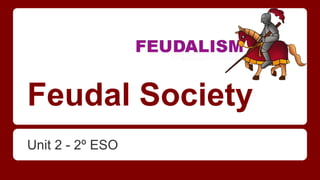
Unit 2 Feudal society
- 1. Feudal Society Unit 2 - 2º ESO
- 2. 1- What were the second invasions? -Europe, 850-1100 - weak -> New invasions: 1. Vikings - from Scandinavia -> Great Britain, north of France and south of Italy. 2. Magyars - from the Asian steppes -> Eastern Europe. 3. Saracens - muslim pirates from Africa -> attacked the Mediterranean coasts of Europe.
- 4. Vikings
- 5. Magyars They came from the steppes of Asia and conquered the territories in Eastern Europe. They created the Kingdom of Hungary.
- 6. Saracens They were muslim pirates, they did not establish in any territory, they just attacked to obtain valuable items.
- 7. Homework Exercises 1 and 2 on page 19. Exercise 2 individually, write a small paragraph about the vikings including their way of life, beliefs and economy. You can use this web: http://www.bbc.co.uk/schools/primaryhistory/vi kings/
- 8. 2- What was feudalism? ORIGIN After the Carolingian Empire, Europe was very divided in small kingdoms which were weak. Kings were weak, they hadn’t army, so they couldn’t defend people. Peasants had to depend on nobles power for their protection. In exchange, they worked for the nobles.
- 11. Homework Exercise 2 on page 20.
- 12. The powers of the king and his court Kings were not really powerful under feudalism. They had limited powers. They depend on their alliances with the noblemen. The court was formed by a group of lawyers, clergy and soldiers, who helped the king to govern.
- 13. Exercises Exercises 1 and 2 on page 21.
- 14. 3- What was a fief? In Medieval times land was broken up into fiefs. But a fief was more than just a piece of land. A fief had to include at least one village with huts for the serfs, a manor house or castle for the noble, and land to grow or catch food. A fief was not ownership. A fief was a loan from the king and the king could take it back. Sometimes fiefs were given as reward for bravery in battle. To get a fief you had to promise the king several things. First, you would give your loyalty to the king; second, you would fight or send men to fight if the king needed them; third, you would provide money to ransom the king if he was captured; finally, you would take care of the serfs working the land.
- 16. 4- How was medieval society organised?
- 17. Homework Exercises 1 and 2 on page 23.
- 18. 5- Who were the nobles? There were rich and poor nobles. Their main activity was fighting. They started military training from childhood. They had to pass through different stages to become a knight (page, squire, and knight). They trained at tournaments.
- 19. Noblewomen Their function was to marry and have children. They also organised the servants. Marriages were arranged by parents. If they did not marry they went into convents. They had to obey their husbands and rarely left the castle.
- 20. Exercises 1 to 3 on page 24.
- 21. 6- Who were the clergy? The Catholic Church was very important in Medieval times in Western Europe. The head was the Pope. He ruled the Papal State with Rome as its capital. The Pope was powerful because he could excommunicate a King. Below the Pope: -Secular clergy: Bishops -Regular clergy: religious orders
- 23. Religious orders The rule was the document in which the order member duties were contained. Some orders were closed (they cannot go out of the monastery). Each order has its own habit. Some orders required their members to beg. Others imposed absolute poverty.
- 24. Life in monasteries They spent most of their time in prayer and meditation. They worked to obtain food, and also helped poor and sick people. Some monks worked copying manuscripts decorated with miniatures.
- 25. Homework Exercises 1 and 2 on page 25.
- 26. 7- How did peasants live? There were different classes: -Serfs: subjected to the Lord. Not free. Work but not paid. Hereditary. -Freemen: paid taxes, rent land but keep part of the harvest. Free to make their own decisions.
- 27. Everyday life Peasants usually lived in small villages. They had small huts for them and their animals (in case they had). The father was the head of the family. Peasants were self-sufficient. They did not live well (poor food, illnesses, natural disasters…).
- 28. The peasant’s work The whole family worked all day. They had very basic tools and no fertilisers. They had to use the fallow system (2 year rotation). The main production was cereal, but also fruits and vegetables, and some families had animals (the richer).
- 29. Homework Exercises 1 and 3 on page 27.
- 30. Revision activities On page 28-29, exercises 1, and 3 in your notebooks. Extra work to turn in through Edmodo: exercise 2.
